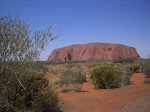|
Uluru (Ayers Rock) and Kata Tjuta (The Olgas)
Uluru - Kata Tjuta National Park and the Ayers Rock Resort is the center of Australia and is considered to be the center for much of the Aboriginal Art world. Around this park and nearby Alice Springs are many Aboriginal owned and operated Art Centres where local Aboriginals can either work on their art or bring their work for display and sale.
These Centres are more accessible to the art buyer or interested tourist than traveling to the remote outback villages where many of the artists live. Visitation to some of those villages is not permitted and most require four wheel vehicles and good weather to find.
As a major place for art, it is useful to learn about the area and the significant roll it plays in the history and beliefs that comprise much of Aboriginal Art.
The Uluru - Kata Tjuta National Park has an area over 311,000 acres and comprises two main significant sites:
Sunset and sunrise over Uluru and Kata Tjuta are spectacular, with the colours at both sites becoming more vibrant and even changing. Uluru and Kata Tjuta have significant meaning to Aboriginal people. They both form an important focus of their spiritual life.
The History
The Central Australian landscape, of which Uluru and Kata Tjuta are an important part, is believed to have been created at the beginning of time. The Anangu Aboriginal people are responsible for the protection and appropriate management of these ancestral lands. The knowledge necessary to fulfil these responsibilities has been passed down from generation to generation.
During the 1870s, William Giles and William Gosse were the first white explorers to this region. Giles was the first to reach Kata Tjuta and named it The Olgas after the then reigning Queen Olga of Wurttemburg. Gosse, however, was the first to reach Uluru and named it Ayers Rock after his superior, Sir Henry Ayers, the Chief Secretary of South Australia.
In the early 1900s the Government declared ownership of the land and by the 1950s tourists and miners had begun to make tracks to Uluru and Kata Tjuta. At the time only a few Anangu were living at Uluru. However, as tourist numbers grew, most of the Anangu there scattered into other regions within Central Australia.
By the early 1970s, the pressure of tourism was having detrimental effects on the environment and the government agreed in 1973 to relocate accommodation facilities to a new site.
It was not until 1979 that, in recognition of the existence of traditional Aboriginal owners of Uluru and Kata Tjuta, a national park was acknowledged. In 1983 Prime Minister Hawke announced the government's intention to grant ownership of the land back to the traditional owners. The agreement, however, required the traditional owners to lease the park to the Australian National Parks and Wildlife Service for a period of 99 years.
Tjukurpa - The Creation Period
Anangu life revolves around the Tjukurpa (sometimes wrongly referred to as the Dreamtime). To the Aboriginal people, this is the ancestral period of when the world was being formed.
At Uluru, Mala (hare wallaby), Kuniya (woma python) and Liru (poisonous snake) are considered to be very important ancestors to the region.
These stories and many others have been passed down through thousands of years from generation to generation. The elder people recount, maintain and pass on this knowledge through stories, behaviour, rituals, ceremonies, songs, dances and art. Tjukurpa is therefore the basis of all Anangu knowledge and connects everything in life.
Sacred SitesThe cultural landscapes of Uluru-Kata Tjuta National Park resonate with meaning. They contain creation stories and the associated knowledge of law, relationships, plants, and animals, all of which live in the shapes and features of the land.
Places where significant events in the Anangu story occurred are held as sacred sites. Anangu have the responsibility and obligation to care for the land in a proper way. As such, tourists are not permitted access to certain significant or sacred sites. Even inadvertent access to these can be sacrilegious.
At Uluru-Kata Tjuta National Park some areas are fenced off and sometimes photography is restricted to ensure that visitors do not inadvertently contravene Tjukurpa restrictions.
Can You Climb Uluru?Aboriginal traditional owners would prefer visitors to not climb Uluru. There are two reasons for this:
NOTE: Some information within this post came from material gathered at Voyages which is a unique Australian travel company offering unique holiday experiences in some of Australia's most remote and breathtaking locations. With Vovages you can choose from an array of award-winning resort accommodation and tours from the red heart of Central Australia to the vibrant colours of the Great Barrier Reef. Please visit their web-site at http://www.voyages.com.au/  |
Saturday, August 29, 2009
Uluru and Kata Tjuta's Influence On Aboriginal Art
Subscribe to:
Post Comments (Atom)



















No comments:
Post a Comment